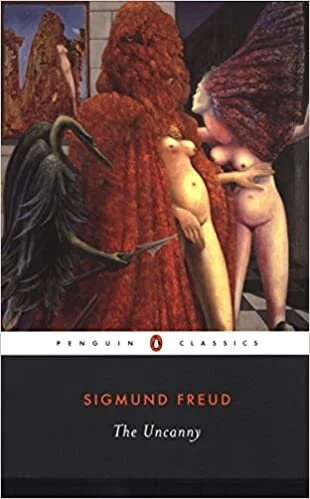Summary: Freud, The Uncanny
Editor’s Note: For this assignment, I needed to read and summarize the published piece or content listed below, and then provide a response or assessment of the writing.
Summary
Freud defines the uncanny as an unfamiliar terrifying feeling that is familiar at the same time to an individual. He further defines the uncanny as something familiar that has been repressed (due to its terrifying nature) and eventually comes to light. He uses the German words heimlich (defined as familiar) and unheimlich (defined as unfamiliar) to explain the uncanny. Freud explores the definitions of these two words and finds that the word heimlich holds multiple definitions, including that of its opposite, unheimlich, making it both familiar and unfamiliar, or in Freud’s terms, the uncanny. Freud illustrates his definition of the uncanny by summarizing “The Sandman,” a story about a young boy who is haunted throughout his life by the childhood story of the Sandman, a character unknown to the reader as real or imagined, who removes children’s eyes. Freud relates this story and the main character’s fear of having his eyes cut out of his head back to his theory of man’s castration-complex when he states, “A study of dreams, phantasies and myths has taught us that a morbid anxiety connected with the eyes and with going blind is often enough a substitute for the dread of castration.” Freud also believes that “a particularly favourable condition for awakening uncanny sensations is created when there is intellectual uncertainty whether an object is alive or not.” Freud believes the wooden doll in “The Sandman” illustrates this point as the main character unknowingly falls in love with this inanimate object and is sent into a state of madness when he realizes the doll is inanimate and not alive. While Freud provides several examples that bring about uncanny feelings he makes a point to state that “not everything that is connected with repressed desires.” Freud then turns his focus to feelings of uncanny in literary works. He states that there is a “differentiation between the uncanny that is actually experienced, and the uncanny as we merely picture it or read about it.” Freud states that the uncanny in literature can include elements of the uncanny in real life, but it also includes a sense of separation between reality and the reader that allows for greater instances of the uncanny: “a great deal that is not uncanny in fiction would be so if it happened in real life; and in the second place that there are many more means of creating uncanny effects in fiction than there are in real life.” This premise changes and the uncanny is limited to that of the real world, however, when the author places his literary setting in reality.
Response
Reading about Freud is fascinating to me because I do not understand how people, scholars, and critics of his time recognized his theory as valid. I think it’s an incredibly creative theory that definitely could be true, but there is no way to prove its validity with objective data. Combined with the fact that his theory is so far out of left field, I’m baffled as to why it was not only considered, but also used, by scholars and critics for so many years. To me, his theory is a deconstructionist’s free association taken to an extreme with little to no evidentiary support. Freud himself states that, “if it does not rest upon mere coincidence, it furnishes a beautiful confirmation of our theory of the uncanny” when introducing some of his examples to support his definition of the uncanny. I’m not saying I think his entire theory is preposterous because I think people certainly have repressed feelings that could unknowingly or unexpectedly come to light. His definition of the uncanny also rings true to me, as well as how the uncanny has more opportunity for creation in literature or film. His evidentiary examples, however, could be nothing more than coincidence and feelings that aren’t necessarily individually repressed feelings, but rather, feelings that were developed in society through cultural developments, such as literature and film. For instance, until Stephen King’s It came along, did people generally have a creepy sense of clowns? I’d argue no. After It, I think a far greater number of people fear clowns. That isn’t a result of a repressed individual feeling, but rather, a cultural influence. That being said, Freud is certainly entertaining.
